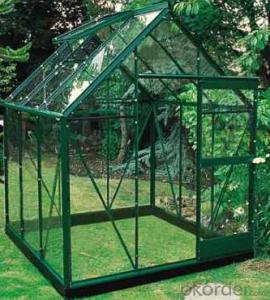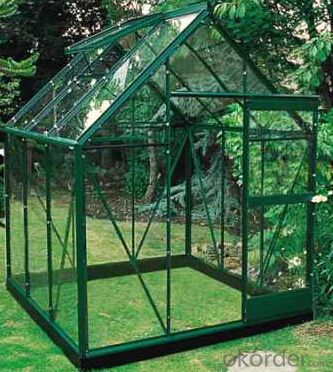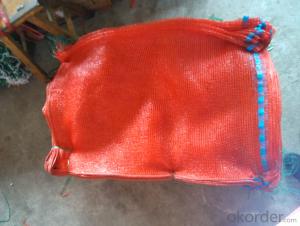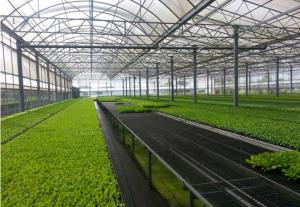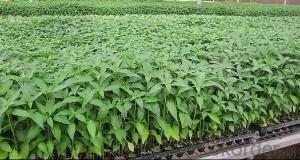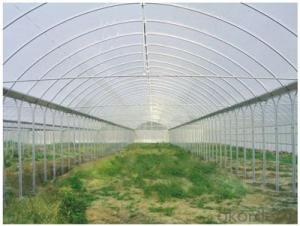Agricultural Multi-span Greenhouse for plants/flowers
- Loading Port:
- Shanghai
- Payment Terms:
- TT OR LC
- Min Order Qty:
- 10 set
- Supply Capability:
- 1000 set/month
OKorder Service Pledge
OKorder Financial Service
You Might Also Like
Specifications
1-Multi-span Greenhouse
2-Hot Sale products of our company
3-Large Inside Room,good for large area
4-Custom-made for you
1. Features:
A. Multi-span greenhouse is more stronger than tunnel greenhouse, Foundation is required.
B. Multi-span greenhouse can use bigger inside room, suitable for large area.
C. Multi-span greenhouse is usually used to grow vegetables such as tomato, cucumber, chili etc, also grow cut flowers
2. Structure:
A. All multi-span greenhouse structure by hot galvanized steel pipe, Anti-rust for 10-15 years.
B. The main structure is consisted by Side Column, Inside Column , End Side Column, Gutter and Arch & Post over the Gutters
and lattice-bars
3. Covering material:
The multi-span greenhouse is covered by 3-ply (PE+EVA Material) poly film (plastic film)
A.130micron/150micron/180micron/200 micron thickness for your choice
B. Anti-UV, anti-drip
C. Temperature range -40 C to +60 C.
D.3 years guarantee, 5 years life
E. Other covering materials (shade net/insect net) are available
4. Technical Parameter
Wind Load: 130KM/H, Snow Load: 0.28KN/m2, Max. Rainwater Running Capacity140mm/h
- Q: How are plastic shade sails used in horticulture?
- Plastic shade sails are commonly used in horticulture to provide temporary or permanent shade for plants, protecting them from excessive sunlight and heat. They are often installed in greenhouses, nurseries, or outdoor gardens to regulate temperature, reduce water evaporation, and prevent sunburn on delicate plants. Additionally, shade sails can be easily adjusted or removed to allow for sunlight exposure when needed, making them a versatile and practical solution for horticultural applications.
- Q: Can agricultural plastic products be used for composting?
- Yes, agricultural plastic products can be used for composting, but it depends on the type of plastic used. Some agricultural plastics, such as biodegradable or compostable plastics, are specifically designed to break down in composting conditions. However, traditional plastics commonly used in agriculture, like polyethylene, are not suitable for composting as they do not easily degrade.
- Q: Can plastics be fused together in the oven safely?If so, which types of plastics is safe to fuse together in the oven and non-toxic? And, if so, at what temperature is it safe?I know plastic bags can be fused together with an iron, but Im looking for cutting up plastic bottles and fusing layers together for projects.Thank you for your help.
- (If other pages at the site are indicated on that page for more info on a particular topic, use the alphabetical navigation bar on the left to get to that page.) P.S. Of course, polymer clay is a plastic too (that's what the rest of my site is about) and is excellent for fusing layers together. HTH and have fun, Diane B.
- Q: How do agricultural plastic products help with soil compaction prevention?
- Agricultural plastic products, such as mulch films and silage bags, help with soil compaction prevention by providing a physical barrier between the soil and external factors. The plastic films create a protective layer, reducing the impact of heavy machinery or foot traffic on the soil surface. This prevents the soil particles from being compressed and compacted, allowing for better water infiltration, root development, and overall soil health.
- Q: Can nursery trays be used for starting succulent seeds?
- Yes, nursery trays can be used for starting succulent seeds. However, it is important to ensure that the trays have proper drainage holes to prevent waterlogging, as succulent seeds are prone to rotting if overwatered. Additionally, using a well-draining soil mix specifically formulated for succulents can increase the success rate of germination.
- Q: Can ground cover be used to create a raised bed cover?
- Yes, ground cover can be used to create a raised bed cover. Ground cover plants, such as low-growing perennial plants or thick mulch, can be used to cover the surface of a raised bed. This helps to retain moisture, suppress weed growth, and protect the soil from erosion. However, it's important to choose ground cover plants that won't compete with the crops in the raised bed for nutrients or water.
- Q: So.....I bought a precooked ham, and removed the plastic cover protection the bone, and I guess when I turned the ham around to make sure there were not other plastic parts, I insterted it into another location!!!! I didn't notice it until transporting the ham from the pan I cooked it in (at 275) to the carving board, so I'm not exactly sure were it was. The plastic piece is fully intact. Is it okay for us to eat??? I can't handle the thought of throwing away Christmas dinner, especially on a budget and the ham wasn't cheap!!
- However, sometimes cooks use them in ways other than intended by the manufacturer. By mistake, consumers have left the paper- or plastic-wrapped giblets inside the turkey during cooking, neglected to take the plastic protector off ham bones, and cooked the absorbent paper-and plastic pad which can be packaged under meat in foam trays. Do these and other mistakes leave the food unsafe to eat? Here are the answers from the USDA Meat and Poultry Hotline. Leaving the paper- or plastic-wrapped giblets inside the turkey during cooking: Some giblets are paper wrapped before being inserted into the poultry body cavity. In this case, there would be no concern if the giblets are accidentally cooked inside the bird to a safe temperature. If giblets were packed in a plastic bag, and the bag has been altered or melted by the cooking process, do not use the giblets or the poultry because harmful chemicals may have migrated into the surrounding meat. If the plastic bag was not altered, the giblets and poultry should be safe to use as long as the meat is fully cooked. Neglecting to take the plastic protector off ham bones: The plastic bone guard covering the exposed bone is used to keep the bone from breaking the outer wrap. If left on the meat during cooking, a 325 or 350 °F oven temperature may not melt the plastic but still give off an abnormal chemical odor or taste. Cutting away the meat around the exposed area will not necessarily solve this potential food safety problem because the penetration of the chemical into the meat will be unknown. If meat is cooked in a closed container, the chemicals may penetrate the entire piece of meat. USDA advises not to eat the ham; discard it. I'm sorry for the bad news.
- Q: Is it safe to use a plastic bucket for a boiler pot while distilling moonshine?
- Yes okorder
- Q: Are agricultural plastic products durable?
- Yes, agricultural plastic products are generally durable. They are specifically designed to withstand various weather conditions, UV exposure, and the wear and tear associated with farming activities.
- Q: How do you prevent pests in nursery trays?
- To prevent pests in nursery trays, it is important to implement a few key measures. Firstly, using clean and sterilized trays, pots, and tools can help reduce the risk of pests and their eggs being introduced. Secondly, practicing good hygiene and regularly cleaning the nursery area, including removing any plant debris or fallen leaves, can eliminate potential habitats for pests. Additionally, implementing a strict monitoring system to regularly inspect plants for signs of pests or diseases allows for early detection and prompt action. Finally, adopting preventive measures such as using organic pest control methods, introducing beneficial insects, or applying insecticidal soaps can help deter and control pests effectively while minimizing harm to the plants and the environment.
Send your message to us
Agricultural Multi-span Greenhouse for plants/flowers
- Loading Port:
- Shanghai
- Payment Terms:
- TT OR LC
- Min Order Qty:
- 10 set
- Supply Capability:
- 1000 set/month
OKorder Service Pledge
OKorder Financial Service
Similar products
Hot products
Hot Searches
Related keywords
